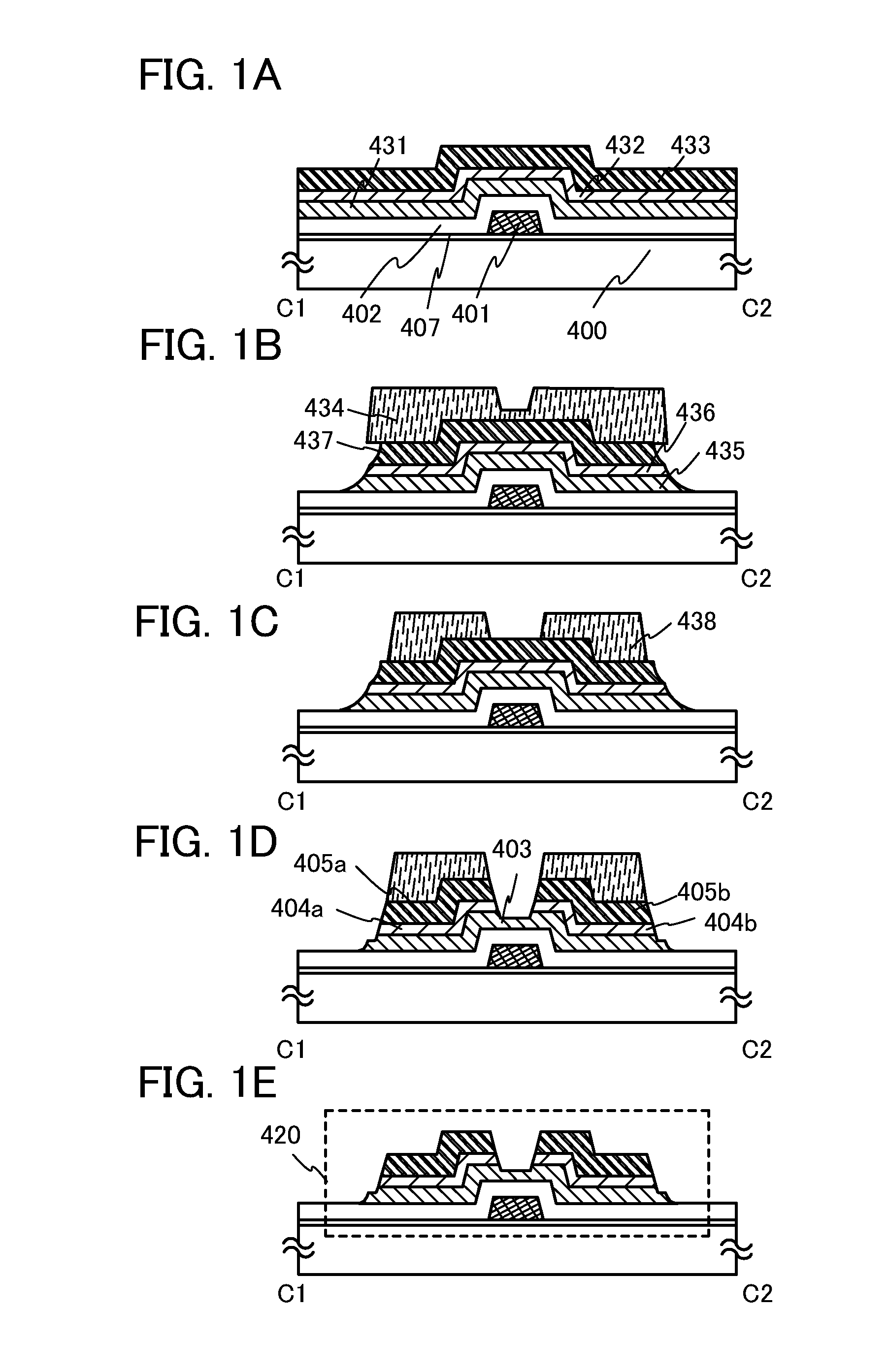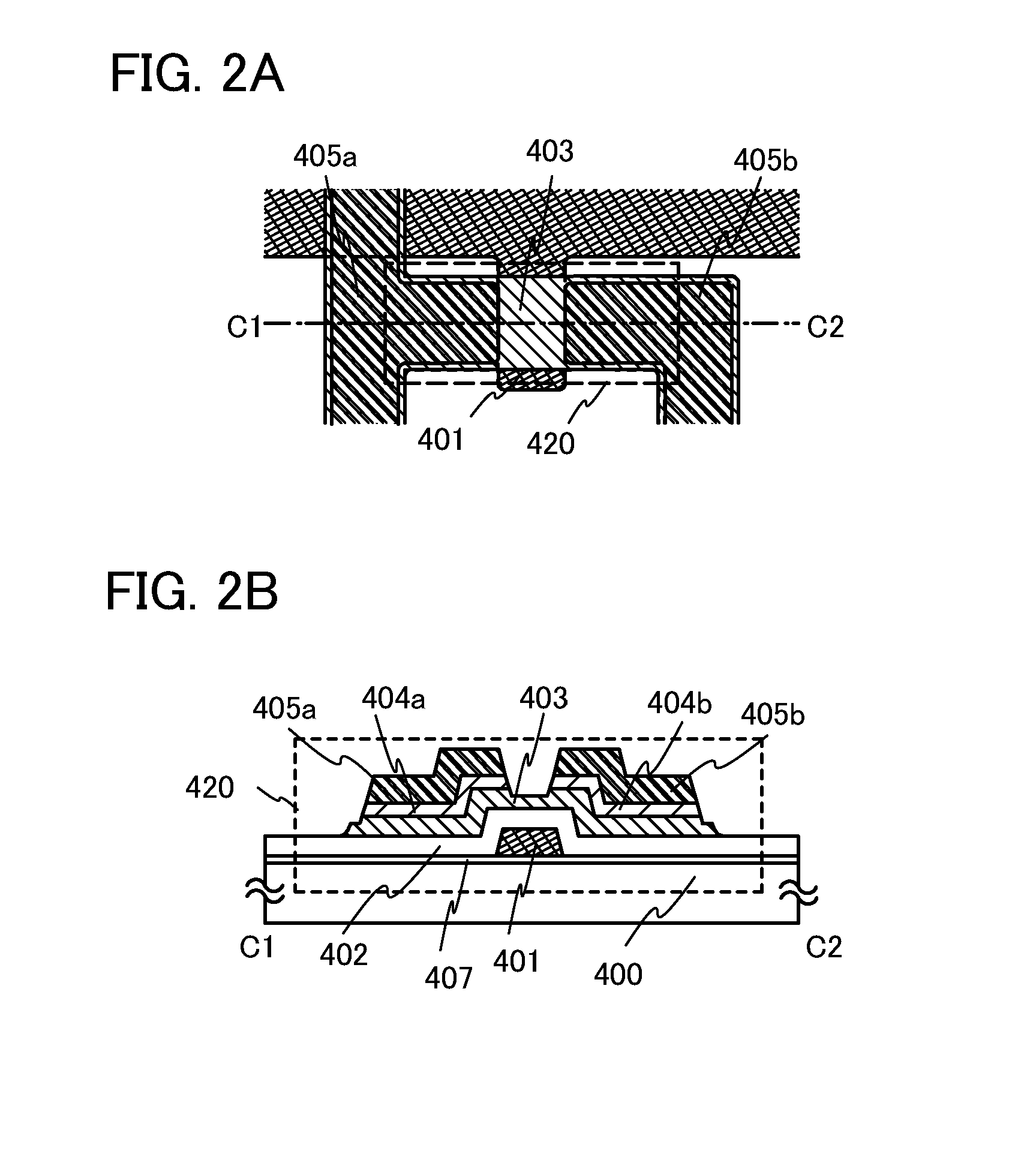Method for manufacturing thin film transistor using multi-tone mask
a technology of multi-tone masks and thin films, applied in non-linear optics, instruments, optics, etc., can solve the problems of affecting production, yield, manufacturing cost, etc., and achieve the effect of reducing the number of light-exposure masks, and simplifying the photolithography process
- Summary
- Abstract
- Description
- Claims
- Application Information
AI Technical Summary
Benefits of technology
Problems solved by technology
Method used
Image
Examples
embodiment 1
[0062]A method for manufacturing a semiconductor device of this embodiment is described with reference to FIGS. 1A to 1E and FIGS. 2A and 2B.
[0063]FIG. 2A is a plan view of a thin film transistor 420 of a semiconductor device of this embodiment, and FIG. 2B is a cross-sectional view taken along C1-C2 of FIG. 2A. The thin film transistor 420 is an inverted staggered thin film transistor and includes a gate electrode layer 401, a gate insulating layer 402, a semiconductor layer 403, n+ layers 404a and 404b serving as a source region and a drain region, and source and drain electrode layers 405a and 405b.
[0064]FIGS. 1A to 1E correspond to cross-sectional views illustrating steps of manufacturing the thin film transistor 420.
[0065]In FIG. 1A, an insulating film 407 serving as a base film is provided over a substrate 400 and the gate electrode layer 401 is provided over the insulating film 407. The insulating film 407 has a function of preventing diffusion of an impurity element from th...
embodiment 2
[0115]Here, an example of a semiconductor device including a thin film transistor with a structure where the source and drain electrode layers are in contact with the semiconductor layer in Embodiment 1 is described with reference to FIGS. 3A to 3E and FIGS. 4A and 4B.
[0116]FIG. 4A is a plan view of a thin film transistor 460 in a semiconductor device of this embodiment, and FIG. 4B is a cross-sectional view taken along D1-D2 of FIG. 4A. The thin film transistor 460 is an inverted staggered thin film transistor and includes a gate electrode layer 451, a gate insulating layer 452, a semiconductor layer 453, and source and drain electrode layers 455a and 455b.
[0117]FIGS. 3A to 3E are cross-sectional views illustrating steps of manufacturing the thin film transistor 460.
[0118]In FIG. 3A, an insulating film 457 serving as a base film is provided over a substrate 450 and the gate electrode layer 451 is provided over the insulating film 457. In this embodiment, a silicon oxide film (with...
embodiment 3
[0149]In this embodiment, a process for manufacturing a display device including a thin film transistor is described with reference to FIGS. 5A to 5C, FIGS. 6A to 6C, FIG. 7, FIG. 8, FIG. 9, FIG. 10, FIGS. 11A, 11B, 11C, and 11D, and FIG. 12.
[0150]As for a substrate 100 having a light-transmitting property illustrated in FIG. 5A, a glass substrate of barium borosilicate glass, aluminoborosilicate glass, or the like which is typified by #7059 glass, #1737 glass, or the like manufactured by Corning, Inc. can be used.
[0151]Next, a conductive layer is formed entirely over a surface of the substrate 100, and then a first photolithography process is performed to form a resist mask. Then, an unnecessary portion is removed by etching, so that wirings and electrodes (a gate wiring including a gate electrode layer 101, a capacitor wiring 108, and a first terminal 121) are formed. At this time, the etching is performed so that at least an end portion of the gate electrode layer 101 is tapered....
PUM
| Property | Measurement | Unit |
|---|---|---|
| temperatures | aaaaa | aaaaa |
| gate voltage | aaaaa | aaaaa |
| diameter | aaaaa | aaaaa |
Abstract
Description
Claims
Application Information
 Login to View More
Login to View More - R&D
- Intellectual Property
- Life Sciences
- Materials
- Tech Scout
- Unparalleled Data Quality
- Higher Quality Content
- 60% Fewer Hallucinations
Browse by: Latest US Patents, China's latest patents, Technical Efficacy Thesaurus, Application Domain, Technology Topic, Popular Technical Reports.
© 2025 PatSnap. All rights reserved.Legal|Privacy policy|Modern Slavery Act Transparency Statement|Sitemap|About US| Contact US: help@patsnap.com



